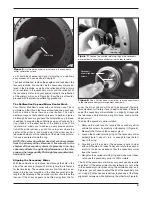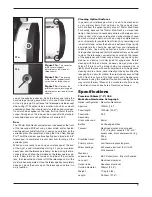
7
cap on the eyepiece opening. Keep the telescope inside the
hard storage carrying case when not in use. Store it indoors
or in a dry garage. Do not leave the telescope outside except
when using it. The optical tube is aluminum and has a smooth
anodized surface that should resist scratches and smudges.
If a scratch does appear on the tube, it will not harm the tele-
scope. Smudges on the tube can be wiped off with standard
household cleaners such as Windex or Formula 409.
Dew
The 190mm Mak-Newt’s corrector lens is exposed at the front
of the telescope. Without using a dew shield and/or heated
dew zapper (available from Orion), dew can easily form on the
corrector glass. We recommend using the Orion Dew Zapper
Pro™ with the medium aperture heating band (made for 6-8"
telescopes) to completely prevent dew from forming on the
corrector glass.
When you are ready to pack up your telescope at the end
of the night, avoid immediately storing it if you encountered
heavy dew and the telescope is damp. Instead, bring the tele-
scope inside and allow the moisture on the telescope to evap-
orate. If dew forms on the inside or outside of the corrector
lens, then leave the dust cover off of the telescope until all the
moisture has evaporated. Once the telescope has completely
dried out, place the dust cap on the telescope and store it in
a dry location.
Cleaning Optical Surfaces
In general, your telescope will only need to be cleaned on
a very minimal basis. Dust particles on the corrector lens
will not affect the optical quality of your 190mm Mak-Newt.
Fortunately, because the 190mm Mak-Newt is a closed tube
design, the primary and secondary mirrors will barely accumu-
late any dust (if dust caps are kept on during storage). Loose
dust can simply be blown off with air, using a compressed air
can or blower bulb (available from Orion). Any remaining dust
is best left alone, unless the build up is extreme. Finger prints
and water marks should be cleaned from your telescope’s
corrector lens. Any quality optical lens tissue and cleaning
fluid specifically designed for multi-coated optics can be used
to clean the telescope’s corrector lens as well as the lenses
of the eyepieces and finder scope. Never use regular glass
cleaner or cleaning fluid designed for eyeglasses. Before
cleaning with fluid and tissue, however, blow any loose par-
ticles off the lens with a blower bulb or compressed air, or
lightly brush the lens with a soft camel hair brush. Apply some
cleaning fluid to a tissue, never directly on the optics. Wipe the
lens gently in a circular motion, then remove any excess fluid
with a fresh lens tissue. Oily fingerprints and smudges may
be removed using this method. Use caution; rubbing too hard
may scratch the lens! Clean only a small area at a time, using
a fresh lens tissue on each area. Never reuse tissues.
Specifications
Premium 190mm (7.5") f/5.3
Maksutov-Newtonian Astrograph
Optical configuration: Maksutov-Newtonian
Aperture
190mm (7.5")
Focal length:
1000mm (39.37")
Focal ratio:
f/5.3
Secondary
mirror minor axis:
64mm
Baffles:
5 knife-edge baffles
Focuser:
Machined aluminum dual-speed
(10:1) Crayford, accepts 1.25" or 2"
accessories, brass compression ring
fitting
Drawtube travel:
30mm
Primary mirror:
Low thermal expansion glass
Mirror coatings:
Enhanced aluminum (94%) with
SiO
2
overcoat
Meniscus
corrector lens:
BK-7 Schott glass, fully multi-coated
Lens cell:
Machined aluminum
Optical tube:
Seamless aluminum
Outside diameter:
235mm (9.25")
Weight:
10 kg (22 lbs.)
Length:
95.25cm (37.5")
Figure 11a.
The corrector
plate Lateral support
adjustment screws (one of
three shown).
Figure 11b.
The primary
mirror Lateral support cover
screw (two of three shown).
Figure 11c.
Detail of the
primary mirror Lateral support
adjustment screw (one of three
shown).
11c
11a
11b



















